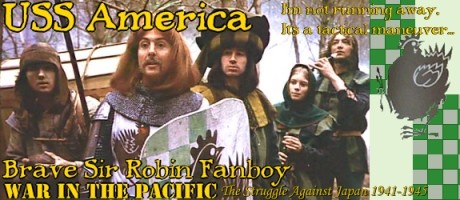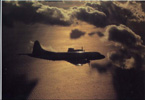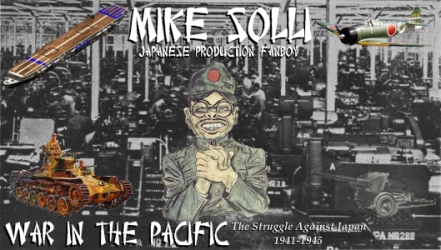ChezDaJez
Posts: 3436
Joined: 11/12/2004
From: Chehalis, WA
Status: offline

|
quote:
I have to call BS on this. Supposedly Chez is in this position because he plays a more historically based game style. Really? because historically the Japanese did ignore the western SRA while they set off to invade, oh say, Samoa. Chez hasn't played historically because if he had we wouldn't be having this conversation. He would have focused soley on the SRA until it was totally secured. In RL, the Japanese didn't consider expanding their perimeter before the beginning of May. Every action prior to that was soley focused on securing the SRA or Burma
Actually, Japan did advance in several Pacific areas while simultaneously advancing through the SRA... Guam, Wake, Tarawa, Rabaul... these are all places that come to mind that Japan took during the first two months. Plus they invaded New Guinea in March capturing Lae and Salamuea.
Let me eplain something about playing a "historical" game. Just because a player restricts himself to historical tactics doesn't mean he must also restrict himself to the historical strategy. And just because he does not follow historical strategy to the letter does not mean that he doesn't recognize the political and military limitations inherent to implementing any strategy. And it is those limitations that I especially will attempt to adhere to within reason. I will admit that I do tend to ignore the political divisions between the IJA and the IJN. I ignore it much like the allied player ignores the bitter disputes between the Nationalist and Communist Chinese leaders.
I believe my strategy pretty much followed the historical Japanese strategy in advancing through the SRA. I don't understand why you think it didn't. My objectives in taking the SRA did follow the historical planning pretty much. I planned on securing the PI reasonably quickly and then advancing with the PI forces in a double pincer movement towards the SW. One prong advancing down Borneo taking Tarakan and Balikpapn, the other advancing towards Kendari and Ambon. These forces would then turn northwards to invade southern Java. This happened IRL.
At the same time, my Malayan forces would move down the eastern side of the peninsula by land and leapfrog by ship down the west coast of Malaya before the final assault on Singapore. Malaya pretty much went as planned though the process took much longer than needed. With the exception of landings at Kauntan and Mersing, I again followed historical strategy. I also sent forces marching towards Burma, just as the Japanese did IRL. Unfortunately Dan had other ideas about Burma and quickly forced a retreat.
The problem with Singapore was that not only did Dan manage to delay its capture but he also greatly whittled down my air forces in doing so. This allowed Dan to move ships in and out of Singapore pretty much as he wanted without much threat of air attack. My surface ships still posed a threat but many of those required significant yard periods before long.
Where I did not follow historical strategy was in the central Pacific after Rabaul had fallen. I deviated by planning to advance through the Solomons into New Caledonia and then eastward towards Fiji and Pago Pago. I did not use any troops that were assigned to take the SRA to accomplish this. It wasn't until I landed at Pago Pago did I encounter any significant difficulty with securing the place. Dan's stalwart and very aggressive defense ensured that progress would be slow and that I would have to leave enough forces behind to guard the place, a place lesson that required learning a couple of times. But the Central Pacific had nothing to do with the issues encountered in the SRA.
quote:
FatR said:
"Not really. Both Singapore and most of the Philippines can be easily bypassed and isolated. In my opinion, the key to Japanese success in the initial phase is speed and preventing the Allies from reinforcing or consolidating their defenses by securing key bases very early. You have only a few weeks of total Allied weakness in the air, so they need to be used to the fullest."
This is easily the defining difference between a gamer and a simulator. A gamer will look at your statement and say, "Yeah, absolutely, that's what you have to do to win." A simulator looks at your statement and thinks, "What? Are you crazy? That would never work IRL!"
One point to make here about the game mechanics. The Japanese player gets a mega-move for certain preordained TFs on the first turn. Mess with the destinations of those TFs and they revert to normal speed. No mega-move allowed. Good luck getting to Sumatra now before the allies reinforce.
And I believe that anyone who contemplates moving on Sumatra without Singapore and northern Java in his hands has committed a fatal error much worse than my arriving too late to take Palembang. He may be able to prevent Dutch land forces from moving into Sumatra from Java but he can not stop allied reinforcements from landing anywhere they chose on Java, Sumatra or Malaya. Nor can he stop the Dutch air force from redeploying to Sumatra. And if the Japanese player has ignored Java and Malaya, where are all those great air bases going to be located that will allow the Japanese player to interdict allied reinforcements?
Anyways, there is nothing wrong with anyone's style of play. Just because someone doesn't play the way you do dosen't mean the other person is playing a bad game. And when two players of different camps oppose each other, it can actually be fun. And it has been fun to play Dan. In a way, playing Dan helps me understand what the allied generals must have thought in 1940 France. I'm sure they were thinking, "What the hell was that?" as Guderian abd his blitzkrieg went screaming by.
Chez
_____________________________
Ret Navy AWCS (1972-1998)
VP-5, Jacksonville, Fl 1973-78
ASW Ops Center, Rota, Spain 1978-81
VP-40, Mt View, Ca 1981-87
Patrol Wing 10, Mt View, CA 1987-90
ASW Ops Center, Adak, Ak 1990-92
NRD Seattle 1992-96
VP-46, Whidbey Isl, Wa 1996-98
|
 Printable Version
Printable Version



























 New Messages
New Messages No New Messages
No New Messages Hot Topic w/ New Messages
Hot Topic w/ New Messages Hot Topic w/o New Messages
Hot Topic w/o New Messages Locked w/ New Messages
Locked w/ New Messages Locked w/o New Messages
Locked w/o New Messages Post New Thread
Post New Thread